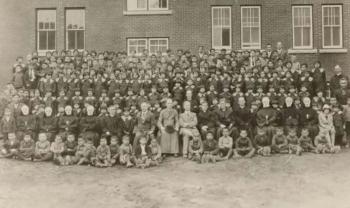Image Caption
Summary
Local Journalism Initiative Reporter
Windspeaker.com
Today, the Piikani Nation in southern Alberta begins its search for unmarked graves at one of the four residential schools that operated on its land.
The ground penetrating radar (GPR) search will be undertaken by the federally-contracted SNC-Lavalin and will begin at the Roman Catholic Mission School.
That school site was selected in a partnership between the Piikani working group and the band’s Lands Department, says spokesperson Carolynn Small Legs.
The working group, which consists of band councillors, department employees and Elders, youth and members-at-large, was officially launched on Aug. 17, she says, although they began meeting before then.
The working group has been tasked with keeping the community informed, as well as consulting with “our Elders on anything with regards to the sites,” says Small Legs, and determining with the community the next steps.
She says the community decided to begin the search for unmarked graves after the findings at the former Kamloops Indian Residential School. The Tk’emlúps te Secwe̓pemc Nation announced in May that 215 probable undisclosed, unmarked burials had been identified on that site by using GPR.
“I think the Kamloops initiative started the process with every community. Once those results came back, communities wanted to know and make sure that we examine those sites as well, and that we do the proper process in ensuring if there’s any unmarked graves found that we would take care of putting them to rest in a peaceful and respectful way,” said Small Legs.
While the community wants to get the search started, Small Legs says they are well aware of “the pain and the grief that may come especially if we do find anything.”
She points out that Piikani Prevention and Counselling Services will be available for members as the search goes through all four sites and in the days to follow. In fact, Dimples Stump, director of the counselling services, is a member of the working group and has been involved from the start.
The Indian Residential School Settlement Agreement (IRSSA), implemented in 2007, lists the federally-funded residential schools included in the settlement. The Piikani Nation has two schools listed: Sacred Heart Indian Residential School (also known as the Mission School) and St. Cyprian (Victoria Home). Former students of these schools were eligible for compensation through the IRSSA.
According to the National Centre for Truth and Reconciliation (NCTR), the Sacred Heart institution operated from 1887 to 1961 and was known under a variety of names from 1893 to 1926, including as the Roman Catholic Mission School. In 1926, the federal government approved the school’s official name to Sacred Heart. Canada funded the school which was managed by the Roman Catholic Church with the assistance of the Reverend Sisters of Charity from 1887 to 1929. From June 1929 until it closed, the school was jointly managed and operated by the federal government and the Roman Catholic Church. Enrollment statistics at the school are inconsistent with numbers varying from as low as eight in 1896 to as high as 91 in 1955, but there are also reports of overcrowding.
The NCTR website lists the names of 45 children who died at Sacred Heart.
According to NCTR, the St. Cyprian school was operated by the Anglican Church from 1927 to 1961. However, St. Cyprian’s was the final replacement for a variety of schools. In 1878 the Anglicans established St. Peter’s Mission, a day school, which was replaced by the residential school, Peigan Mission Home in 1890. Because that school was too small, it was replaced by Victoria Jubilee Home for Indian Children in 1897. However, because of that school’s location on the banks of the Pincher Creek and flooding every spring, St. Cyprian’s was built on higher ground and opened in 1927. It experienced serious overcrowding which led to the federal government closing it in 1961.
The NCTR website lists the names of seven children who died at St. Cyprian’s.
Small Legs says it is not known how long it will take to do the GPR work at the Mission School. She also did not know the size of the area to be scanned.
“Once we get the results back from SNC … then we will communicate with our community and our Elders to determine the next steps and how we will communicate what was found to media,” said Small Legs.
Small Legs would not speculate on what options would be considered if probable burial sites are located.
She says each site will be done to completion, for both scanning and finding out results, before moving on to the next site.
She stresses that all work will be undertaken in a “thorough, thoughtful, and respectful” manner.
The federal government is covering the cost of the scanning.
In mid-June, the Alberta government announced $8 million in funding to support community-led research into undocumented deaths and burials in residential schools. Communities can access a maximum of $150,000 and Small Legs says they will be looking into that.
She said they will also be looking at funding of $2.8 million announced in July by the province to provide mental health supports for those impacted by the residential school system.
Local Journalism Initiative Reporters are supported by a financial contribution made by the Government of Canada.

